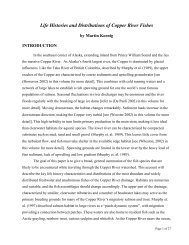Mitigation for the Construction and Operation of Libby Dam
Mitigation for the Construction and Operation of Libby Dam
Mitigation for the Construction and Operation of Libby Dam
You also want an ePaper? Increase the reach of your titles
YUMPU automatically turns print PDFs into web optimized ePapers that Google loves.
Table 5. T-test results. This table shows <strong>the</strong> result <strong>of</strong> t-tests <strong>for</strong> <strong>the</strong> Grave Creek Phase I<br />
Restoration Project evaluation. Hypo<strong>the</strong>sized response assumes describes if <strong>the</strong> metric should<br />
increase or decrease if conditions in <strong>the</strong> stream improve. For example, Taxa Richness should<br />
increase if <strong>the</strong> restoration improved <strong>the</strong> quality <strong>of</strong> <strong>the</strong> stream <strong>for</strong> macroinvertebrates. Similarly,<br />
as more taxa inhabit a healthy stream we expect <strong>the</strong> dominance <strong>of</strong> sediment tolerant groups<br />
(such as Collectors, Sprawlers, or burrowers) should decrease.<br />
A priori /<br />
post hoc<br />
ANALYSIS<br />
METRICS<br />
HYPOTHESIZED<br />
RESPONSE TO<br />
RESTORATION<br />
RESTORATION<br />
MEAN - 2002<br />
RESTORATION<br />
MEAN - 2003<br />
a priori Taxa Richness Increase 32.7 31 0.842<br />
a priori EPT Richness Increase 21 18 0.584<br />
a priori % EPT Increase 8.67 10.33 0.446<br />
a priori<br />
Baetidae:<br />
Ephemeroptera<br />
Decrease 0.360 0.118 0.0850<br />
a priori % Diptera Decrease 38.1 29.3 0.719<br />
a priori<br />
a priori<br />
post hoc<br />
% Burrowers &<br />
Sprawlers<br />
% Collector<br />
Ga<strong>the</strong>rers<br />
Decrease 18.5 22.3 0.849<br />
Decrease 49.2 50.5 0.877<br />
% Collector<br />
Decrease 1.55 0.41 0.207<br />
Filterers 8<br />
post hoc % Collectors 9 Decrease 50.7 50.7 > 0.999<br />
post hoc % Predators 10 8.70 7.16 0.496<br />
post hoc % Shredders 11 Increase 1.91 7.77 0.054<br />
post hoc %<br />
Ephemeroptera 12 Increase 63.8 53.2 0.433<br />
post hoc % Plecoptera 13 Increase 8.46 10.1 0.594<br />
post hoc % Trichoptera 14 Increase 5.37 4.08 0.658<br />
post hoc<br />
% Dominant taxa<br />
(3)<br />
Decrease 54.25 48.32 0.390<br />
P<br />
8 % Collector-filterers was tested post hoc to explain <strong>the</strong> examine changes in community function.<br />
9 % Collectors total was tested post hoc to explain <strong>the</strong> examine changes in community function.<br />
10 % Predators was tested post hoc to explain <strong>the</strong> examine changes in community function.<br />
11 % Shredders was tested post hoc to explain <strong>the</strong> examine changes in community function.<br />
12 % Ephemeroptera was tested post hoc to explain <strong>the</strong> cause <strong>of</strong> differences in <strong>the</strong> % EPT metric.<br />
13 % Plecoptera was tested post hoc to explain <strong>the</strong> cause <strong>of</strong> differences in <strong>the</strong> % EPT metric.<br />
14 % Plecoptera was tested post hoc to explain <strong>the</strong> cause <strong>of</strong> differences in <strong>the</strong> % EPT metric.<br />
78
















